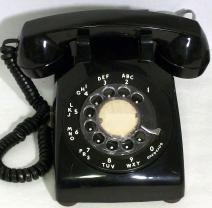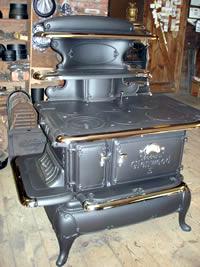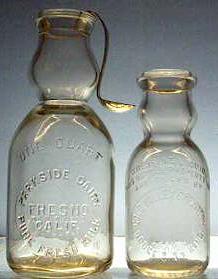
But these expectations persisted even as the cost of long-distance calls declined. It eventually became quite inexpensive to telephone from Boston to New York, yet my grandparents never quite got over the idea that such calls were a luxury. If I did telephone from Boston, they would wrap up the conversation quickly, to save me money. The country was divided into "zones", and the price of a "long-distance" call depended on distance. I was actually startled when phone companies started offering long-distance tariffs independent of distance - a monthly charge that allowed calls to be made to anywhere in the United States. Yet it made sense. Long-distance cables and microwave links carry thousands of calls at once, and don't account for much of the cost to the telephone company of a call. The majority of their cost is in what they call "the last mile" - the wires running from the local telephone exchange to your house. Thinking about this was probably the first time I realized that there is not much of a relationship between the cost of something and its price (other than the price having to at least cover the cost). The telephone companies kept charging a premium for "long-distance" calls long after it made any sense, because customers had gotten used to the idea. Young people these days don't even have the concept of "long-distance" calls. See the following cartoon, which is old enough to have been taken down from the Zits website:  Technological changes affect our language, and can make some words seem odd. We still say that a telephone "rings", even though the sound they make often sounds nothing like a bell. We still talk of "dialing" a telephone, even though most telephones don't have dials any more. The photo at the top of this entry shows what I would call a "dial telephone" (sometimes called a "rotary telephone"). But in my youth, we only called them "dial telephones" when they were first introduced. They displaced telephones with no dial or buttons, which you picked up, and an operator said, "Number, please". But after a while, we just called them "telephones", since all telephones had dials. The noun phrase "dial telephone" is called a "retronym", defined by Wikipedia as follows: "A retronym is a type of neologism that provides a new name for an object or concept to differentiate its original form or version from a more recent form or version. The original name is most often augmented with an adjective (rather than being completely displaced) to account for later developments of the object or concept itself. Much retronymy is driven by advances in technology." In addition to "dial telephone", some other examples of retronyms are acoustic guitar, snail-mail, World War I, black-and-white television (and for that matter, color television), and so on. By the way, thinking back, I'm surprised at how long it took for people to get the idea that all ringing telephones don't have to sound the same. Originally, the issue was technological. The ringing signal on an old-fashioned "POTS" telephone line ("Plain Old Telephone Service") was a 90-volt sine wave, which would directly drive the clapper on a physical bell. But once ring tones started getting generated electronically, anything was possible. What things have become foreign to our children? In October, 2011, the Oxford English Dictionary removed "cassette tape" from its Concise edition to make room for words such as "retweet" and "cyberbullying". An article on the subject in a blog on the San Francisco Chronicle shows quite a few examples - you can scroll through some photos. Some of those either shown, or mentioned in the many comments that followed the article were:
Pretty much all my correspondence is now by e-mail. But there still seem to be some things hanging on for which it doesn't seem proper to use e-mail. These are things like wedding invitations, and thank-you and condolence notes. Not only are some of these done on paper, they are also generally written out by hand. But schools are starting to drop the teaching of cursive writing, now considered to be an obsolete skill. I typed personal letters for years, even before the computer, since I could type much faster than I could write, and my handwriting has never been the best. But some people objected to this. An Argentinean exchange student to whom I wrote after she returned home wrote that she was "shocked" by my typed letter, complaining that it looked like a telegram. Some other things our kids won't know about? When a group of people separated at some venue (a mall, a fair, etc.), we had to arrange for a place and a time to meet. Even if we didn't intend to separate, at a crowded event, we had to say, "If we get separated, we'll meet at X at such-and-such a time." Now, with cell phones, this is all unnecessary. Margie and I frequently use our cell phones to locate each other in a big store like Costco. Our kids will never see a car with the headlight dimmer switch on the floorboard, to be clicked with the left foot. Or windshield wipers that sped up and slowed down with your vehicle's acceleration, because they were driven by the intake manifold vacuum, instead of by an electric motor. They may eventually forget the origin of the words "clockwise" and "counterclockwise", if "analog watches" (another retronym) become uncommon. People will have no idea what "film" was for a camera. Nor will they remember that it was quite expensive to buy film, develop it, and have prints made, and we were careful not to take too many pictures. Note 1
Since the milk was not homogenized, the cream would separate, and float to the top. You could insert a special spoon or disk to pour off the cream, leaving a bottle of skim milk. Or you could shake it before pouring to mix in the cream and get whole milk. Click the next link to see the discussion of "cream top (separating) bottles" (scroll down a bit). Some of the things our children no longer experience are real losses, like the beauty of the Milky Way in a pitch-black night sky, or listening to dramas on the radio (The Lone Ranger, The Shadow, Dragnet, and so on). And perhaps, the ability to experience total silence. Do you have any recollections of other things we have lost, and other words that have changed? Write me an e-mail message, and perhaps some day I'll include them in a follow-on blog entry called "Oldthink (bis)". My grandparents could never get out of their heads the notion that all floors are cold. They would often scold us as children when they saw us sitting on the floor of my childhood home. In fact, that house (rather a pioneer for a house built in 1948) was heated by what is called "radiant heating", with pipes carrying hot water under the floor. The floor was warm, not cold. In fact, if you sat in one place for a while, you might want to move to avoid getting too hot. I wonder what sort of nonsense I still believe.   Note 1: Film and prints were so expensive because the chemistry of photography was based on silver, specifically silver nitrate. At the Eastman Kodak Company, every workday started off dissolving 99.95% pure silver bars in 67% nitric acid. By 1936, the company was processing five tons of silver a day, and it only went up from there, until the advent of digital photography. [return to text]  |
 In the 1960's, whenever I visited my parents in Great Neck, New York while on a vacation from college in Cambridge, Massachusetts, I was expected to phone my grandparents to say hello. This expectation continued after I graduated, and settled in the Boston, Massachusetts area. I was not expected to telephone them from Boston, because, after all, "long-distance" calls were expensive.
In the 1960's, whenever I visited my parents in Great Neck, New York while on a vacation from college in Cambridge, Massachusetts, I was expected to phone my grandparents to say hello. This expectation continued after I graduated, and settled in the Boston, Massachusetts area. I was not expected to telephone them from Boston, because, after all, "long-distance" calls were expensive.


 On the cast-iron stove top, circles could be removed using a special handle that came with the stove, to allow the fire below to come to bear directly on a pot or pan being heated. At least one of these areas had multiple nested rings, as shown to the right, to allow a circular hole of various diameters to be opened.
On the cast-iron stove top, circles could be removed using a special handle that came with the stove, to allow the fire below to come to bear directly on a pot or pan being heated. At least one of these areas had multiple nested rings, as shown to the right, to allow a circular hole of various diameters to be opened.
 In those days, milk was commonly delivered to your house, in glass bottles that were returned when empty, to be washed and re-used. I recall milk being delivered in special bottles, with a separate area at the top of the bottle for the cream (examples can be seen to the right).
In those days, milk was commonly delivered to your house, in glass bottles that were returned when empty, to be washed and re-used. I recall milk being delivered in special bottles, with a separate area at the top of the bottle for the cream (examples can be seen to the right).